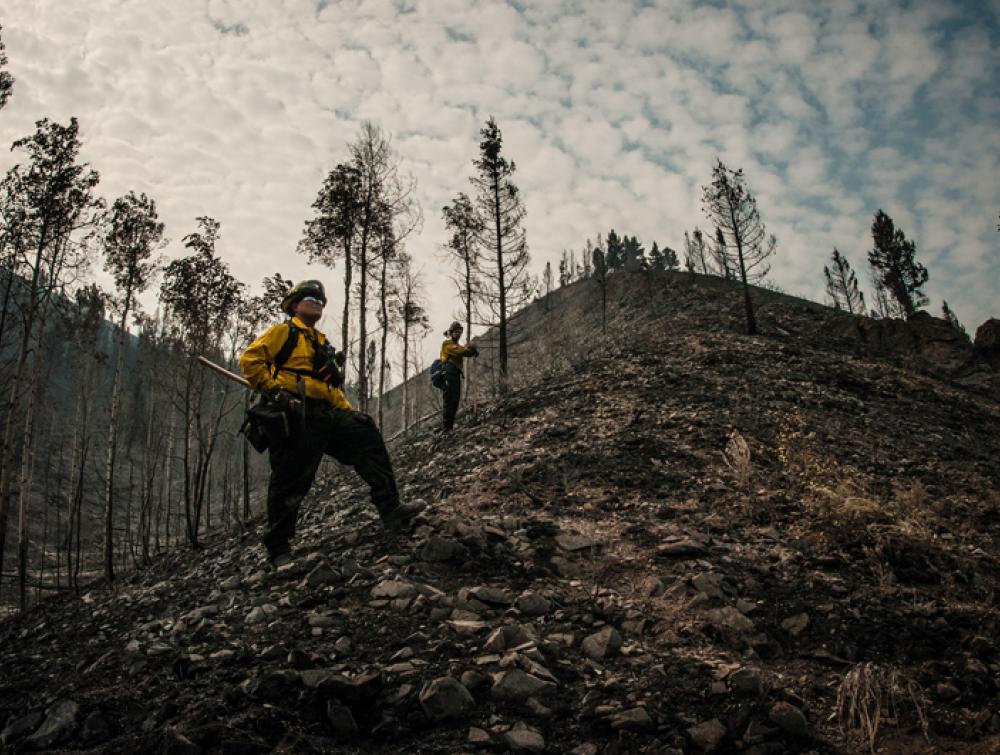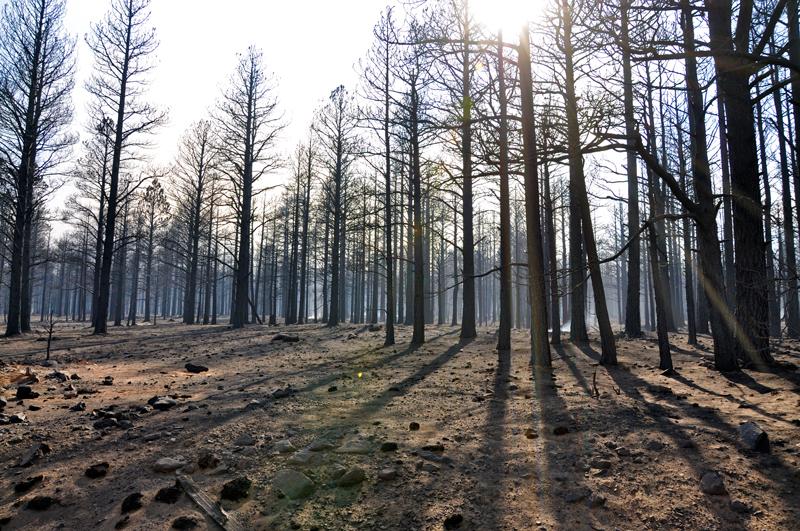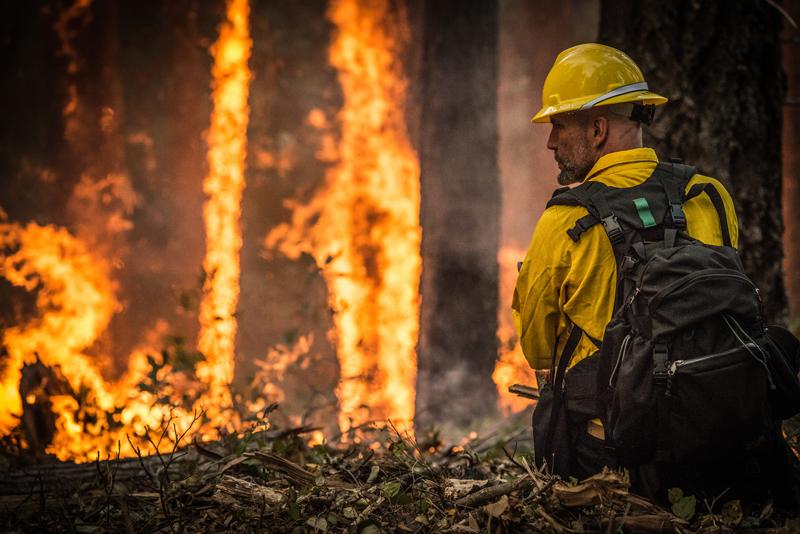5 big myths about wildfire

A firefighter on U.S. Forest Service land in Idaho.
Lance Cheung (USDA), flickr
Tragic losses from wildfires demand we confront growing threats and dispel myths that surround them
The scale of life and property lost due to large wildfires like those in California is shocking and painful. These fires are growing bigger and more destructive than ever before due to climate change, drought, a lack of funding for prevention programs and other factors, and figuring out how to fight them is an urgent public safety matter.
Unfortunately, wildfires are frequently misunderstood. Especially with more and more people moving and building homes closer to wildlands, it is vital that we separate wildfire myths and facts.
1. Myth: Wildfires are natural and should be allowed to burn freely
Reality: Driven by climate change, wildfires pose a huge threat and demand careful forest management practices
Recent research implicates climate change for doubling the total area burned by wildfires across the western U.S. in the last three decades. As climate change continues apace, experts say fires will probably keep getting biggerand more destructive, spurred by ever drier and hotter weather.
These factors, plus encroaching development and a long history of policies that unwisely prevent fires from burning in our forests, mean that wildfires now present a greater danger to humans and the environment than ever before.
In addition to supporting policies that reduce greenhouse gas emissions and tackle climate change directly, how do we counter these factors? One of the most effective ways to protect people and property from wildfires is to reduce the available “fuel” around homes and communities. Creating “defensible space” around homes and cutting down some trees within a half-mile of forest communities is one of the best strategies to protect lives and property. Proponents of the timber industry suggest that thinning forests will help solve problems, but the type of logging they do is in the backcountry and far from communities. Logging in these more remote areas degrades water quality, recreation experiences and wildlife habitat and does not make people safer from wildfire.
A specific type of logging, “salvage logging,” is particularly damaging. Salvage logging refers to the removal of burned trees after a fire. While this may sound harmless, scientists say that burned trees left in the wake of fires serve an important role in western forests, spurring improved biodiversity and supporting life ranging from shrubs to bears. In fact, removing these trees could actually exacerbate fire damage and increase future risk, not to mention sending excessive ash and sediment into area streams.
To pay for the right kind of forest management activities, it’s important to provide dedicated funding to respond to wildfire. Fortunately, a deal struck in Congress would do just that starting in 2020.
2. Myth: Logging forests prevents wildfires
Reality: Fires may burn more intensely in logged forests
On a basic level, this argument is sensible; after all, fewer trees means less fire fuel, right? But it's not so simple. Studies have actually found that fires burn more intensely in forests that have been logged. One reason is that the tree remnants left behind in the wake of a logging operation (limbs and tree tops, typically) form a kind of super-charged bed of surface fuel that is dried out thanks to the lack of forest canopy overhead. Another reason is that the new trees that grow in after a forest is logged are all the same age and densely clustered--exactly the kind of trees that burn extra hot and fast, leading to big, intense blazes.
Strategically "thinning" forests is a different story. If trees are cut down in carefully planned locations, in forests that are well-adapted to regular ground fire, the practice can help reduce the intensity of wildfires. Some attempt to conflate thinning with regular logging, or even use it as a pretext to invite the timber industry into our forests; don't fall for it.
3. Myth: All wildfires are bad and should be stopped immediately
Reality: Protecting people is top priority, but fires play an important ecological role
Protection of life and property is always the top priority during any wildfire. However, fire has played an important ecological role in forests for thousands of years. Some species of plants depend on periodic wildfires as part of the natural cycle of recovery, and many other species easily tolerate naturally occurring, periodic fires.

The Coconino National Forest (Arizona) in the aftermath of a fire. Fire can actually play an important role in a forest's natural equilibrium, allowing new life to spring forth.
Brady Smith (USFS), flickr.
Within wilderness areas, the Forest Service aims to permit lightning-caused fires to play their natural ecological role, while at the same time preventing fires from “escaping” and causing damage to nearby communities. Wildfire in wilderness areas creates wildlife habitat, renews soil nutrients and limits the size of subsequent fires by clearing old trees that would otherwise act as “fuel.” Managing wilderness fires with these benefits in mind lowers the risk for firefighters and reduces costs relative to fire suppression.
The Wilderness Act provides broad and flexible guidance for managing fire in wilderness areas. Our wildfire primer provides background on wildfire management law and policy within wilderness areas and includes a specific focus on Forest Service law and regulation.
4. Myth: As wildfires get worse, the Forest Service gets a lot more money to fight them
Reality: As firefighting expenses rise, Forest Service funding has barely budged
Today, the wildfire season is 60 to 80 days longer than it was three decades ago, and fires burn much larger areas. The cost of fighting the fires has gone up, too: In 2015, the Forest Service announced that for the first time in the history of the agency, it was spending more than half its budget to suppress wildfires, up from 13 percent of the agency’s budget in 1991. The Forest Service estimated that within a decade, more than two-thirds of its budget would go to that purpose, nearly $1.8 billion. That estimate now seems optimistic; in 2017, wildfire suppression costs shot past $2.5 billion for the year.
With costs rising, fire funds often run out in the middle of wildfire season. Meanwhile, total funding for the Forest Service has stayed about the same. Spending such a large portion of the agency’s budget on fires means that funds once available for conservation, trail maintenance and forest restoration programs have decreased dramatically. This has been a chronic problem, perpetuating the cycle of extreme fire seasons by neglecting activities that help maintain forest health and reduce the likelihood of future catastrophic wildfires.
In 2018, leaders struck a deal to provide dedicated funding for fighting wildfires for the next 10 years. This was a major breakthrough that should help the Forest Service both manage its vital conservation duties and keep increasingly destructive fires at bay. It will be important for leaders to extend that funding fix in the years to come.
5. Myth: Wildfire spending will continue to skyrocket no matter what
Reality: A more strategic approach to fire management can help address the crisis
This will be true if we don’t find a more responsible way to fund fire suppression and address the causes of rising fire costs. We must approach fire management in a new and strategic way.
One costly aspect of fighting fires is protecting "inholdings." These are usually privately owned homes that are surrounded by national forest land. Protecting such property is a high priority for the Forest Service, but it is also extremely expensive and dangerous.
Those costs can be reduced when federal land agencies purchase inholdings or easements from willing sellers through the Land and Water Conservation Fund and the Forest Legacy Program. The Land and Water Conservation Fund expired in September 2018, and reauthorizing and fully funding it will be a key step to fighting big wildfires.

A firefighter in Oregon oversees a prescribed burn to help stop a larger wildfire.
Lance Cheung (USDA), flickr
Another program, the Collaborative Forest Landscape Restoration Program, encourages science-based ecosystem restoration of priority forest areas. It has helped to reduce wildfire management costs, re-establish natural fire regimens and cut the risk of destructive wildfire. This program will expire in 2019 unless Congress acts to keep it going.
At The Wilderness Society, our scientists are studying wildfire in our national forests and our policy staff is working in Washington to enact policies that protect homes and communities while allowing fire to play its natural role in our forests.
